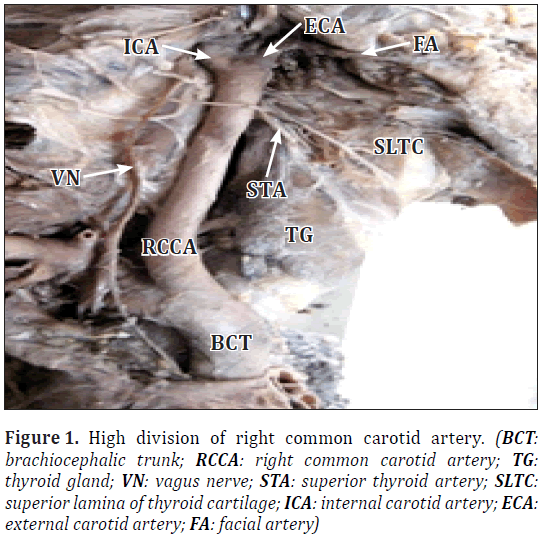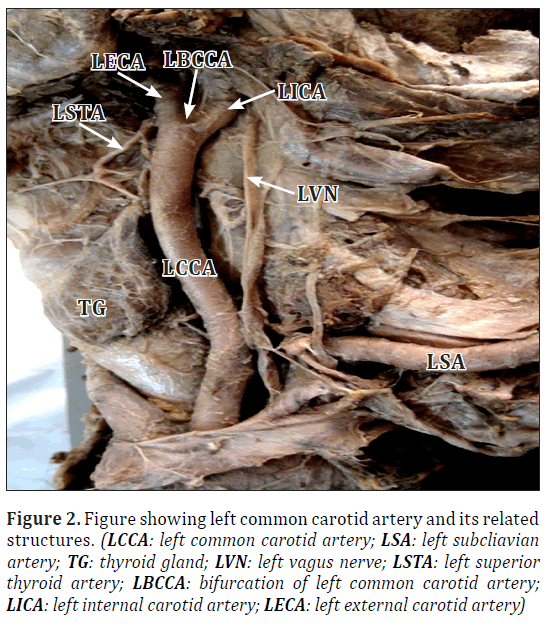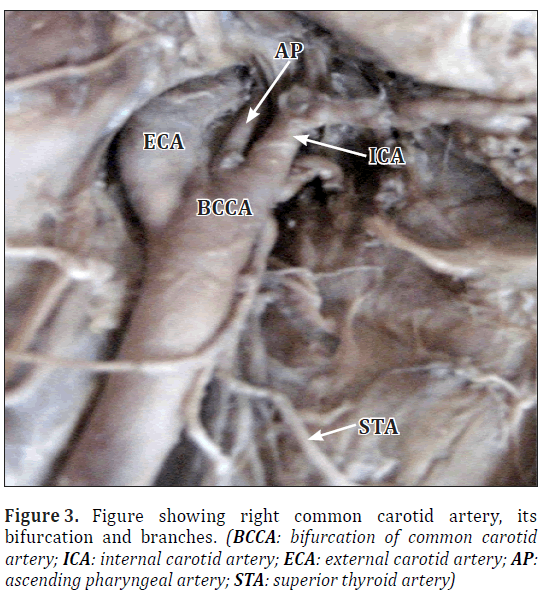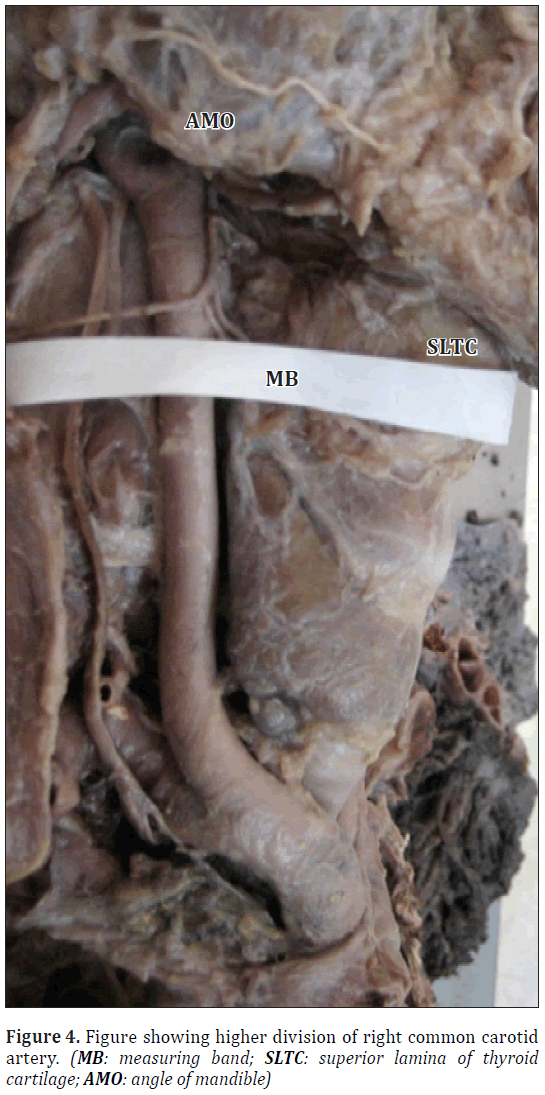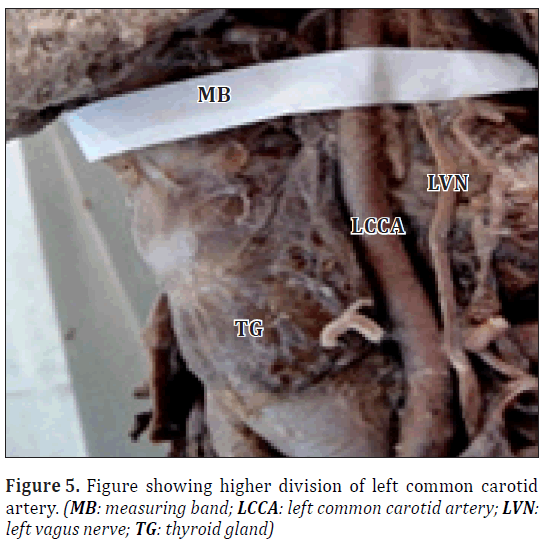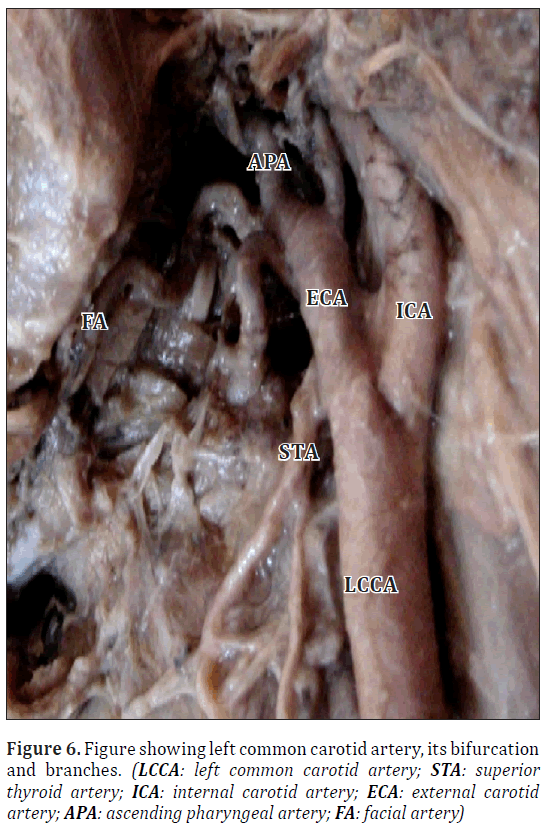Bilateral variations in the divisions of common carotid artery – a case report
Bheemshetty S. Patil*, Shankarappa D. Desai, Ishwar B. Bagoji and Gavishiddappa A. Hadimani
Department of Anatomy, Shri B. M. Patil Medical College, Blde University, Bijapur, Karnataka, India
- *Corresponding Author:
- Bheemshetty S. Patil
Lecturer, Department of Anatomy, Shri B. M. Patil Medical College, Blde University, Bijapur-586103, Karnataka, India
Tel: +91 8352-262770/ext. 2211
E-mail: dr.patilbs@gmail.com
Date of Received: October 10th, 2011
Date of Accepted: August 26th, 2012
Published Online: December 20th, 2012
© Int J Anat Var (IJAV). 2012; 5: 116–119.
[ft_below_content] =>Keywords
common carotid artery, thyroid cartilage, angle of mandible, bifurcation of common carotid artery
Introduction
The right common carotid artery arises from the brachiocephalic trunk behind the right sternoclavicular joint exclusively cervical. The left side artery arises from the arch of aorta and ascends to enter the neck posterior to the sternoclavicular joint. From the joint each artery ascends to the upper border of the thyroid cartilage, at the level of the disc between the third and fourth cervical vertebrae here it divides into internal and external carotid arteries –its only branches. In the neck, the common carotid artery ascends on the subclavian and vertebral arteries to meet the prevertebral fascia on the sixth cervical transverse process (carotid tubercle) anterior to the inferior thyroid artery. The recurrent laryngeal nerve is posterior to the beginning of the right artery; the thoracic duct turns anterolaterally between the left artery and the vertebral vessels. Both arteries are overlapped by the sternocleidomastoid, the infrahyoid muscles, and the thyroid gland, but not in their upper parts. Here they are covered anteriorly by deep fascia, and lie close to the thyroid cartilage. Below this they are separated from pharynx, larynx and trachea inferior to the gland [1]. Carotid bifurcation lies at approximately the level of the upper border of thyroid cartilage. At the bifurcation, the internal carotid usually is posterior/posterolateral to the external carotid, from which always can be distinguished by the fact that it gives off no branches in the neck, whereas the external does [2]. This study reports bilateral variations in the divisions of common carotid artery.
Case Report
D During routine dissection we found bilateral variation in the division of common carotid artery in a 48-year-old male embalmed cadaver. The right common carotid artery originated from the brachiocephalic trunk behind the sternoclavicular joint nominally and ascended up in its course within the carotid sheath, and it was related to the internal jugular vein and vagus nerve (Figure 1). The left common carotid artery arose from the arch of aorta, where it lied in front of the subclavian artery up to the sternoclavicular joint (Figure 2). On right side the brachiocephalic trunk bifurcated behind the sternoclavicular joint into common carotid and subclavian arteries. The common carotid gave off no branches proximal to its bifurcation but except on right side superior thyroidal artery was arising from the right common carotid artery 2.5 cm below the bifurcation of common carotid artery (Figure 3). Common carotid artery lied within the medial part of the carotid sheath with the internal jugular vein lateral to it and vagus nerve deeply placed between the two vessels (Figures 1,2). The sympathetic trunk was behind the artery and outside the sheath, which was overlapped superficially by the infrahyoid muscles and sternocleidomastoid, medial to the sheath was the trachea and esophagus and at the higher level, the larynx and pharynx. The thyroid gland overlapped the sheath anteromedially and inferior thyroid artery crossed from the thyrocervical trunk to the gland behind the sheath. Normally, the bifurcation of common carotid artery is at the level of superior lamina of thyroid cartilage upper border of C4 in to external and internal carotid artery but in this case the bifurcation on both side was higher level above the tip of grater horn, i.e., upper border of C2 vertebra. Around 4.2 cm above the level of C4 vertebra/superior lamina of thyroid cartilage and it was measured by measuring band kept horizontally from the superior lamina of thyroid cartilage to upper border of C4 vertebra (Figures 4,5). The terminal portion of common carotid arteries were dilated and branches that arose from them are normal (Figures 3,6) except right side superior thyroidal artery was arising below the bifurcation of common carotid artery (Figure 3).
Figure 1: High division of right common carotid artery. (BCT: brachiocephalic trunk; RCCA: right common carotid artery; TG: thyroid gland; VN: vagus nerve; STA: superior thyroid artery; SLTC: superior lamina of thyroid cartilage; ICA: internal carotid artery; ECA: external carotid artery; FA: facial artery)
Figure 2: Figure showing left common carotid artery and its related structures. (LCCA: left common carotid artery; LSA: left subcliavian artery; TG: thyroid gland; LVN: left vagus nerve; LSTA: left superior thyroid artery; LBCCA: bifurcation of left common carotid artery; LICA: left internal carotid artery; LECA: left external carotid artery)
Discussion
During development the ventral segment and aortic sac opposite 3rd arch becomes the common carotid artery. The dorsal segment of 3rd arch artery with dorsal aortic arch becomes internal carotid artery. The external carotid artery comes as a new sprout in the aortic sac near the ventral segment of the third arch; if this sprout arises at a higher level than the bifurcation will be at a higher level [3,4]. The bilateral variation in the division of common carotid artery is not common, the earlier reported variation of bifurcation of common carotid artery at higher level has been reported in right side as 12.5%; whereas in left side is 9% [5,6]. In the present case we found bilateral higher division of common carotid artery, and the right superior thyroid artery arising from common carotid artery. Unusual bifurcation of common carotid artery has been one of the risks for damaging of artery during the ear, throat and mandibular surgeries that leads to surgical complications; so the surgeon should aware of this type of variations and prevent the complications like unknowingly damaging or hitting to the artery which may be fatal [7]. A high common carotid artery is at a higher risk of impingement by intra-articular screws during procedures on cervical vertebrae [8]. Variations in the level of origin of the common carotid artery are reported as part of the abnormalities of the supra-aortic trunks. Higher levels of origin are associated with higher incidences of penetrating vascular injuries [9].
Branching pattern of the external carotid artery was as usual but right superior thyroid artery arose from the right common carotid artery. The left external carotid artery branches, facial, ascending pharyngeal arteries were more spiral due to narrow space because of higher division of common carotid artery (Figures 3,6). Endocrinologist and surgeons should have an awareness of all these types of variations.
References
- Romanes GJ. Cunningham’s Manual of Practical Anatomy. Vol. 3. 15th Ed., New York, Oxford Medical Publication. 2007; 77.
- Hollinshed WH, Rosse C. Textbook of Anatomy. 4th Ed., Philadelphia, Harper & Row Publishers. 1985; 835.
- Sadler TW. Langman’s Medical Embryology. 10th Ed., New Delhi, Lippincott Williams & Wilkins, Wolters Kluwer Health (India). 2006; 180–183.
- Hamilton WJ, Mossan HW. Hamilton, Boyd and Mossman’s Human Embryology Prenatal Development of Form and Function. 4th Ed., London, The Macmillan Press Ltd. 1978; 262–267.
- Anangwe D, Saidi H, Ogeng’o J, Awori KO. anatomical variations of the carotid arteries in adult Kenyans. East Afr Med J. 2008; 85: 244–247.
- Zumre O, Salbacak A, Cicekcibasi AE, Tuncer I, Seker M. Investigation of the bifurcation level of the common carotid artery and variations of the branches of the external carotid artery in human fetuses. Ann Anat. 2005; 187: 361–369.
- Schulz UG, Rothwell PM. Sex differences in carotid bifurcation anatomy and the distribution of atherosclerotic plaque. Stroke. 2001; 32: 1525–1531.
- Currier BL, Todd LT, Maus TP, Fisher DR, Yaszemski MJ. Anatomic relationship of the internal carotid artery to the C1 vertebra: A case report of cervical reconstruction for chordoma and pilot study to assess the risk of screw fixation of the atlas. Spine (Phila Pa 1976). 2003; 28: 461–467.
- Stover S, Holtzman RB, Lottenberg L, Bass TL. Blunt innominate artery injury. Am Surg. 2001; 67: 757–759.
Bheemshetty S. Patil*, Shankarappa D. Desai, Ishwar B. Bagoji and Gavishiddappa A. Hadimani
Department of Anatomy, Shri B. M. Patil Medical College, Blde University, Bijapur, Karnataka, India
- *Corresponding Author:
- Bheemshetty S. Patil
Lecturer, Department of Anatomy, Shri B. M. Patil Medical College, Blde University, Bijapur-586103, Karnataka, India
Tel: +91 8352-262770/ext. 2211
E-mail: dr.patilbs@gmail.com
Date of Received: October 10th, 2011
Date of Accepted: August 26th, 2012
Published Online: December 20th, 2012
© Int J Anat Var (IJAV). 2012; 5: 116–119.
Abstract
During routine dissection, we found bilateral variation in the division of common carotid artery in a 48-year-old male cadaver. The right carotid, originated from the brachiocephalic trunk behind the right sternoclavicular joint. The left carotid, originated directly from the aortic arch. Division of common carotid artery occured at higher level; i.e., above the level of superior lamina of thyroid cartilage. On the right side 4.2 cm and on left side 3.5 cm above the superior lamina of thyroid cartilage and just behind the angle of mandible. The arteries did not have any branches; except on the right side the superior thyroidal artery arose from the 2.5 cm below the bifurcation. Knowledge of origin and bifurcation of common carotid artery is very important to the ENT surgeons, general surgeons, endocrinologist and vascular surgeons.
-Keywords
common carotid artery, thyroid cartilage, angle of mandible, bifurcation of common carotid artery
Introduction
The right common carotid artery arises from the brachiocephalic trunk behind the right sternoclavicular joint exclusively cervical. The left side artery arises from the arch of aorta and ascends to enter the neck posterior to the sternoclavicular joint. From the joint each artery ascends to the upper border of the thyroid cartilage, at the level of the disc between the third and fourth cervical vertebrae here it divides into internal and external carotid arteries –its only branches. In the neck, the common carotid artery ascends on the subclavian and vertebral arteries to meet the prevertebral fascia on the sixth cervical transverse process (carotid tubercle) anterior to the inferior thyroid artery. The recurrent laryngeal nerve is posterior to the beginning of the right artery; the thoracic duct turns anterolaterally between the left artery and the vertebral vessels. Both arteries are overlapped by the sternocleidomastoid, the infrahyoid muscles, and the thyroid gland, but not in their upper parts. Here they are covered anteriorly by deep fascia, and lie close to the thyroid cartilage. Below this they are separated from pharynx, larynx and trachea inferior to the gland [1]. Carotid bifurcation lies at approximately the level of the upper border of thyroid cartilage. At the bifurcation, the internal carotid usually is posterior/posterolateral to the external carotid, from which always can be distinguished by the fact that it gives off no branches in the neck, whereas the external does [2]. This study reports bilateral variations in the divisions of common carotid artery.
Case Report
D During routine dissection we found bilateral variation in the division of common carotid artery in a 48-year-old male embalmed cadaver. The right common carotid artery originated from the brachiocephalic trunk behind the sternoclavicular joint nominally and ascended up in its course within the carotid sheath, and it was related to the internal jugular vein and vagus nerve (Figure 1). The left common carotid artery arose from the arch of aorta, where it lied in front of the subclavian artery up to the sternoclavicular joint (Figure 2). On right side the brachiocephalic trunk bifurcated behind the sternoclavicular joint into common carotid and subclavian arteries. The common carotid gave off no branches proximal to its bifurcation but except on right side superior thyroidal artery was arising from the right common carotid artery 2.5 cm below the bifurcation of common carotid artery (Figure 3). Common carotid artery lied within the medial part of the carotid sheath with the internal jugular vein lateral to it and vagus nerve deeply placed between the two vessels (Figures 1,2). The sympathetic trunk was behind the artery and outside the sheath, which was overlapped superficially by the infrahyoid muscles and sternocleidomastoid, medial to the sheath was the trachea and esophagus and at the higher level, the larynx and pharynx. The thyroid gland overlapped the sheath anteromedially and inferior thyroid artery crossed from the thyrocervical trunk to the gland behind the sheath. Normally, the bifurcation of common carotid artery is at the level of superior lamina of thyroid cartilage upper border of C4 in to external and internal carotid artery but in this case the bifurcation on both side was higher level above the tip of grater horn, i.e., upper border of C2 vertebra. Around 4.2 cm above the level of C4 vertebra/superior lamina of thyroid cartilage and it was measured by measuring band kept horizontally from the superior lamina of thyroid cartilage to upper border of C4 vertebra (Figures 4,5). The terminal portion of common carotid arteries were dilated and branches that arose from them are normal (Figures 3,6) except right side superior thyroidal artery was arising below the bifurcation of common carotid artery (Figure 3).
Figure 1: High division of right common carotid artery. (BCT: brachiocephalic trunk; RCCA: right common carotid artery; TG: thyroid gland; VN: vagus nerve; STA: superior thyroid artery; SLTC: superior lamina of thyroid cartilage; ICA: internal carotid artery; ECA: external carotid artery; FA: facial artery)
Figure 2: Figure showing left common carotid artery and its related structures. (LCCA: left common carotid artery; LSA: left subcliavian artery; TG: thyroid gland; LVN: left vagus nerve; LSTA: left superior thyroid artery; LBCCA: bifurcation of left common carotid artery; LICA: left internal carotid artery; LECA: left external carotid artery)
Figure 3: Figure showing right common carotid artery, its bifurcation and branches. (BCCA: bifurcation of common carotid artery; ICA: internal carotid artery; ECA: external carotid artery; AP: ascending pharyngeal artery; STA: superior thyroid artery)
Figure 4: Figure showing higher division of right common carotid artery. (MB: measuring band; SLTC: superior lamina of thyroid cartilage; AMO: angle of mandible)
Figure 5: Figure showing higher division of left common carotid artery. (MB: measuring band; LCCA: left common carotid artery; LVN: left vagus nerve; TG: thyroid gland)
Figure 6: Figure showing left common carotid artery, its bifurcation and branches. (LCCA: left common carotid artery; STA: superior thyroid artery; ICA: internal carotid artery; ECA: external carotid artery; APA: ascending pharyngeal artery; FA: facial artery)
Discussion
During development the ventral segment and aortic sac opposite 3rd arch becomes the common carotid artery. The dorsal segment of 3rd arch artery with dorsal aortic arch becomes internal carotid artery. The external carotid artery comes as a new sprout in the aortic sac near the ventral segment of the third arch; if this sprout arises at a higher level than the bifurcation will be at a higher level [3,4]. The bilateral variation in the division of common carotid artery is not common, the earlier reported variation of bifurcation of common carotid artery at higher level has been reported in right side as 12.5%; whereas in left side is 9% [5,6]. In the present case we found bilateral higher division of common carotid artery, and the right superior thyroid artery arising from common carotid artery. Unusual bifurcation of common carotid artery has been one of the risks for damaging of artery during the ear, throat and mandibular surgeries that leads to surgical complications; so the surgeon should aware of this type of variations and prevent the complications like unknowingly damaging or hitting to the artery which may be fatal [7]. A high common carotid artery is at a higher risk of impingement by intra-articular screws during procedures on cervical vertebrae [8]. Variations in the level of origin of the common carotid artery are reported as part of the abnormalities of the supra-aortic trunks. Higher levels of origin are associated with higher incidences of penetrating vascular injuries [9].
Branching pattern of the external carotid artery was as usual but right superior thyroid artery arose from the right common carotid artery. The left external carotid artery branches, facial, ascending pharyngeal arteries were more spiral due to narrow space because of higher division of common carotid artery (Figures 3,6). Endocrinologist and surgeons should have an awareness of all these types of variations.
References
- Romanes GJ. Cunningham’s Manual of Practical Anatomy. Vol. 3. 15th Ed., New York, Oxford Medical Publication. 2007; 77.
- Hollinshed WH, Rosse C. Textbook of Anatomy. 4th Ed., Philadelphia, Harper & Row Publishers. 1985; 835.
- Sadler TW. Langman’s Medical Embryology. 10th Ed., New Delhi, Lippincott Williams & Wilkins, Wolters Kluwer Health (India). 2006; 180–183.
- Hamilton WJ, Mossan HW. Hamilton, Boyd and Mossman’s Human Embryology Prenatal Development of Form and Function. 4th Ed., London, The Macmillan Press Ltd. 1978; 262–267.
- Anangwe D, Saidi H, Ogeng’o J, Awori KO. anatomical variations of the carotid arteries in adult Kenyans. East Afr Med J. 2008; 85: 244–247.
- Zumre O, Salbacak A, Cicekcibasi AE, Tuncer I, Seker M. Investigation of the bifurcation level of the common carotid artery and variations of the branches of the external carotid artery in human fetuses. Ann Anat. 2005; 187: 361–369.
- Schulz UG, Rothwell PM. Sex differences in carotid bifurcation anatomy and the distribution of atherosclerotic plaque. Stroke. 2001; 32: 1525–1531.
- Currier BL, Todd LT, Maus TP, Fisher DR, Yaszemski MJ. Anatomic relationship of the internal carotid artery to the C1 vertebra: A case report of cervical reconstruction for chordoma and pilot study to assess the risk of screw fixation of the atlas. Spine (Phila Pa 1976). 2003; 28: 461–467.
- Stover S, Holtzman RB, Lottenberg L, Bass TL. Blunt innominate artery injury. Am Surg. 2001; 67: 757–759.




